
Mayotte, officially the Department of Mayotte, is an overseas department and region and single territorial collectivity of France. It is located in the northern part of the Mozambique Channel in the Indian Ocean off the coast of Southeastern Africa, between Northwestern Madagascar and Northeastern Mozambique. Mayotte consists of a main island, Grande-Terre, a smaller island, Petite-Terre, as well as several islets around these two. Mayotte is the most prosperous territory in the Mozambique Channel, making it a major destination for immigration.

This is a list of the 351 communes of the Gard department of France.

Mabuya is a genus of long-tailed skinks, lizards in the family Scincidae. The genus is restricted to species from various Caribbean islands. Species in the genus Mabuya are primarily carnivorous, though many are omnivorous. The genus is viviparous, having a highly evolved placenta that resembles that of eutherian mammals. Formerly, many Old World species were placed here, as Mabuya was a kind of "wastebasket taxon". These Old World species are now placed in the genera Chioninia, Eutropis, and Trachylepis. Under the older classification, the New World species were referred to as "American mabuyas", and as of 2024 include the genera Alinea, Aspronema, Brasiliscincus, Capitellum, Copeoglossum, Maracaiba, Marisora, and Varzea.

La Désirade is an island in the French West Indies, in the Lesser Antilles of the Caribbean. It forms part of Guadeloupe, an overseas region of France.

The French overseas department of Mayotte is divided into 17 communes.
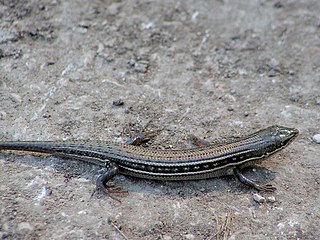
The bridled mabuya or bridled skink is a species of skink found in North Africa and Middle East. They grow up to 22 cm.

Trachylepis is a skink genus in the subfamily Mabuyinae found mainly in Africa. Its members were formerly included in the "wastebin taxon" Mabuya, and for some time in Euprepis. As defined today, Trachylepis contains the clade of Afro-Malagasy mabuyas. The genus also contains a species from the Brazilian island of Fernando de Noronha, T. atlantica, and may occur in mainland South America with Trachylepis tschudii and Trachylepis maculata, both poorly known and enigmatic. The ancestors of T. atlantica are believed to have rafted across the Atlantic from Africa during the last 9 million years.

Rochefort-en-Terre is a commune in the Morbihan department of Brittany in north-western France.
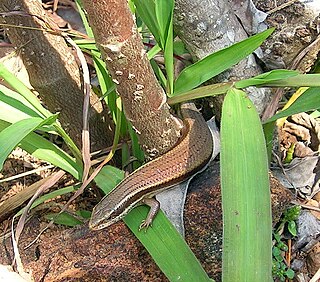
Lygosominae is the largest subfamily of skinks in the family Scincidae. The subfamily can be divided into a number of genus groups. If the rarely used taxonomic rank of infrafamily is employed, the genus groups would be designated as such, but such a move would require a formal description according to the ICZN standards.
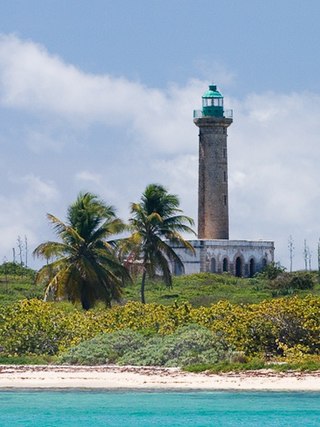
Petite Terre Islands are two small uninhabited islands located about 10 km (6 mi) to the south-east of the island of Grande-Terre (Guadeloupe), in the Lesser Antilles. They are named Petite Terre in contrast with the much larger Grande-Terre.
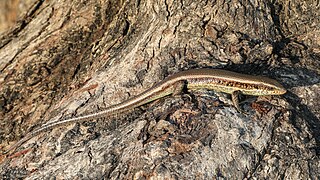
Eutropis is a genus of skinks belonging to the subfamily Mabuyinae. For long, this genus was included in the "wastebin taxon" Mabuya; it contains the Asian mabuyas. They often share their habitat with the related common skinks (Sphenomorphus), but they do not compete significantly as their ecological niches differ. This genus also contains the only member of the subfamily to occur in Australasia, the many-lined sun skink, whose wide range includes New Guinea.

The Noronha skink is a species of skink from the island of Fernando de Noronha off northeastern Brazil. It is covered with dark and light spots on the upperparts and is usually about 7 to 10 cm in length. The tail is long and muscular, but breaks off easily. Very common throughout Fernando de Noronha, it is an opportunistic feeder, eating both insects and plant material, including nectar from the Erythrina velutina tree, as well as other material ranging from cookie crumbs to eggs of its own species. Introduced predators such as feral cats prey on it and several parasitic worms infect it.
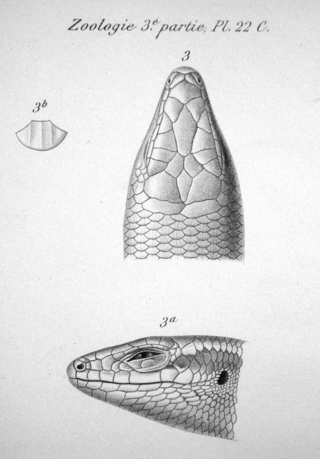
Trachylepis maculata, the spotted mabuya, is a species of skink in the genus Trachylepis recorded from Demerara in Guyana, northern South America. It is placed in the genus Trachylepis, which is otherwise mostly restricted to Africa, and its type locality may be in error. It is an unstriped, olive-brown, grayish animal, with dark spots all over the body. Its taxonomic history is complex due to confusion with Trachylepis atlantica from the Atlantic Ocean island of Fernando de Noronha and doubts regarding its type locality.
Trachylepis tschudii is an enigmatic skink, purportedly from Peru. First described in 1845 on the basis of a single specimen, it may be the same as the Noronha skink (T. atlantica) from Fernando de Noronha, off northeastern Brazil. T. tschudii represents one of two doubtful records of the otherwise African genus Trachylepis on mainland South America; the other is T. maculata from Guyana.
The Greater Martinique skink is a species of skink found on Martinique. It has shiny, bronze-colored skin, with a pair of light stripes that run along its upper flanks.

The Terre-de-Haut racer is a species of snake found in the Caribbean, on the Lesser Antilles. This species is endemic to Terre-de-Bas Island and Terre-de-Haut Island which make up the Îles des Saintes. Terre-de-Bas and Terre-de-Haut are very small islands with a total area of approximately 13 km2. Because of its presence only on this small area, it is a highly protected species.
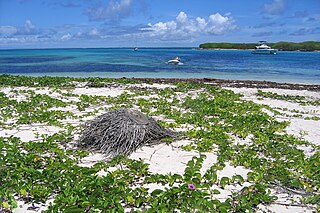
Petite Terre Islands National Nature Reserve is a reserve of the Petite Terre Islands in Guadeloupe. The reserve was established by Decree No. 98-801 of 3 September 1998 as the nature reserve for the islands of Petite Terre. It covers an area of about 990 hectares, which is demarcated by five points fixed with buoys, and includes a land area of 148.6 hectares with the balance as sea area.

Mabuyinae is a subfamily of skinks within the family Scincidae. The genera in this subfamily were previously found to belong the Mabuya group in the large subfamily Lygosominae.
Mabuya grandisterrae, also known commonly as the Grande-Terre skink, is a species of lizard in the subfamily Lygosominae of the family Scincidae. The species is endemic to Guadeloupe. It is considered to be possibly extinct.















